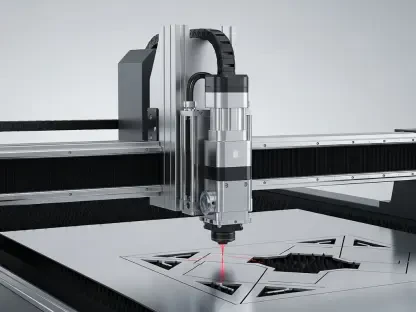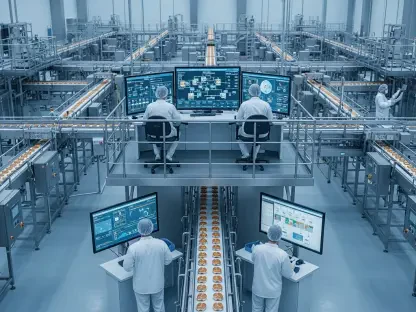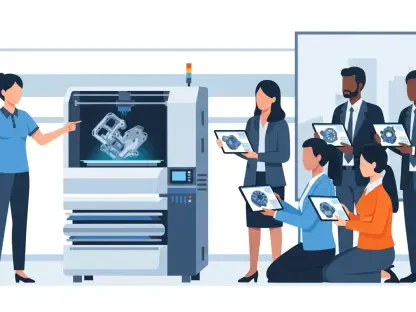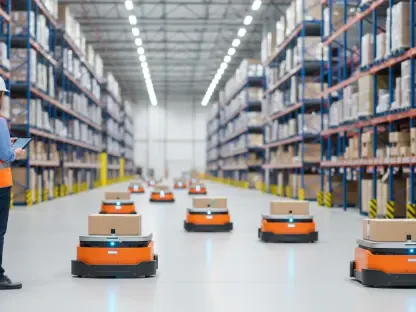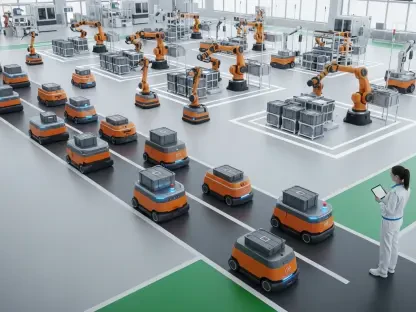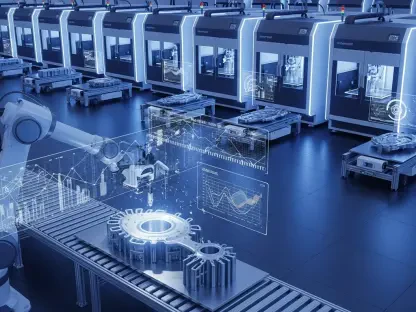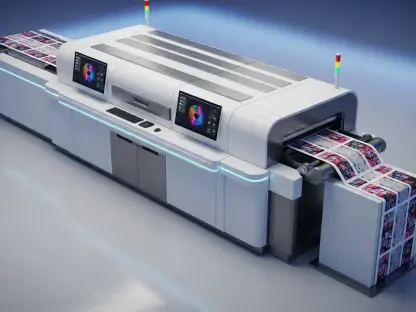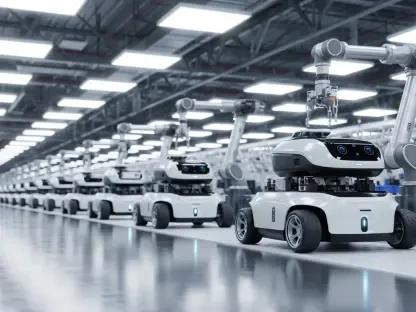The Current Landscape of Manufacturing and the Role of GenAI
Imagine a manufacturing sector struggling to fill critical roles, with nearly one-third of its workforce nearing retirement and younger generations showing little interest in stepping into these positions, painting a stark reality of an industry at a crossroads. This landscape today is marked by an aging demographic, insufficient apprenticeship programs, and a pressing need to modernize operations to stay competitive in a fast-evolving global market.
Generative Artificial Intelligence, commonly referred to as GenAI, emerges as a transformative force capable of addressing these deep-rooted challenges. Unlike traditional automation, this technology goes beyond routine tasks, offering innovative solutions for training, engagement, and operational efficiency. Its ability to adapt and generate human-like responses or content positions it as a game-changer for an industry in desperate need of revitalization.
The scope of GenAI’s influence spans critical segments such as automation of repetitive processes, personalized training platforms, and enhanced workforce engagement through intuitive tools. Major market players are driving adoption with cutting-edge advancements, integrating GenAI into existing systems to streamline production and reduce downtime. This technological shift is reshaping traditional manufacturing processes, paving the way for greater efficiency and fostering a culture of innovation that could attract new talent to the sector.
Key Trends and Market Insights in GenAI Adoption
Emerging Trends Shaping Manufacturing with GenAI
A significant trend reshaping the manufacturing space is the transition into what experts call the “Age of Superagency,” where AI redefines job roles by empowering workers with unprecedented decision-making capabilities. This shift moves employees from mere operators to strategic contributors, leveraging AI to handle complex analyses and mundane tasks alike. Such a transformation is critical for an industry seeking to redefine its image and appeal to a tech-savvy younger workforce.
Another noteworthy development is the rise of Agentic AI, a form of artificial intelligence that autonomously manages tasks and learns from feedback to improve outcomes. This technology enables real-time problem-solving on the factory floor, from quality control to predictive maintenance, reducing human error and boosting productivity. Its potential to operate independently marks a leap forward in how manufacturing can achieve operational excellence.
Workforce dynamics are also evolving, with millennials and Gen Z workers bringing digital fluency that accelerates AI adoption. Their comfort with technology, coupled with market drivers like the demand for efficiency and talent attraction, creates fertile ground for GenAI integration. Additionally, opportunities for creativity are emerging, as workers use AI tools to innovate processes and solve challenges directly at the point of production.
Financial Returns and Growth Projections
Financially, GenAI offers compelling returns, with studies showing an average of 3.7 times the investment per dollar spent, while top industry leaders achieve up to 10.3 dollars in return for each dollar invested. These figures highlight the tangible benefits of adopting such technology, making a strong case for manufacturers to prioritize integration into their strategic plans. The data underscores how AI can drive cost savings and enhance profitability across diverse operations.
Looking ahead, growth projections for AI adoption in manufacturing vary based on company readiness and cultural acceptance, with significant expansion expected from this year through 2027. Companies that have already embraced digital transformation are poised to lead, while others may require more time to align their infrastructure and mindset. This disparity suggests a widening gap between early adopters and laggards, emphasizing the urgency of action.
From a forward-looking perspective, GenAI stands to position manufacturing for long-term competitiveness and resilience against market fluctuations. By streamlining processes and enhancing workforce capabilities, the technology ensures adaptability to changing consumer demands and global economic pressures. This strategic advantage could redefine industry standards over the coming years.
Challenges in Implementing GenAI in Manufacturing
Despite its potential, implementing GenAI in manufacturing is not without hurdles, with trust issues topping the list of concerns. Workers and management often question the reliability of AI systems, necessitating greater explainability to build confidence in automated decision-making. Transparent communication about how these tools function is essential to overcoming skepticism and fostering acceptance.
Technological barriers also pose significant challenges, particularly disparities in data quality and system integration across companies of varying sizes. Smaller manufacturers may lack the robust data infrastructure needed to support GenAI, while larger firms struggle with unifying disparate systems. Addressing these gaps requires tailored solutions and investments in scalable technology to ensure equitable access to AI benefits.
Cultural and leadership barriers further complicate adoption rates in certain organizations, where resistance to change can stifle progress. A mindset shift is crucial, alongside investments in user-friendly AI tools that simplify interaction for all employees. Prioritizing transparency in AI processes and involving staff in implementation discussions can help dismantle these cultural roadblocks, paving the way for smoother transitions.
Regulatory and Compliance Considerations for GenAI in Manufacturing
Navigating the regulatory landscape is a critical aspect of adopting GenAI in manufacturing, with data privacy and security standards at the forefront. Manufacturers must adhere to stringent guidelines to protect sensitive information, ensuring that AI systems do not compromise worker or consumer data. Compliance with these regulations is non-negotiable for maintaining operational integrity and avoiding legal repercussions.
Significant laws and compliance requirements shape how GenAI is deployed, particularly in areas like worker safety and ethical data handling. These regulations often mandate regular audits and risk assessments to guarantee that AI applications align with industry best practices. Staying abreast of evolving legal frameworks is vital for manufacturers aiming to integrate technology responsibly.
The impact of such regulations extends to everyday practices, influencing how data is collected, stored, and utilized within AI systems. Aligning GenAI with ethical guidelines ensures responsible use, maintaining public trust and safeguarding the industry’s reputation. This alignment not only mitigates risks but also positions companies as leaders in ethical innovation, a key differentiator in a competitive market.
The Future of Manufacturing with GenAI Innovations
Looking toward the horizon, GenAI is set to create dynamic, tech-enabled job roles that could redefine the essence of manufacturing work. By integrating advanced tools, the industry can offer positions that blend technical expertise with creative problem-solving, appealing to a new generation of workers. This evolution promises to transform manufacturing into a hub of innovation rather than a relic of the industrial past.
Potential disruptors, such as further advancements in Agentic AI and deeper automation of complex tasks, loom large as game-changers. These innovations could handle intricate production challenges, from supply chain optimization to real-time defect detection, with minimal human intervention. Their development signals a future where efficiency and precision reach unprecedented levels.
Shifts in consumer and workforce preferences toward intuitive, technology-driven solutions will likely accelerate GenAI scalability, influenced by global economic conditions and ongoing innovation. Personalized training tools and real-time problem-solving capabilities on the factory floor stand out as key growth areas. These advancements promise to enhance adaptability, ensuring manufacturing remains agile in the face of future uncertainties.
Conclusion and Strategic Recommendations
Reflecting on the insights gathered, it becomes evident that GenAI has already begun to transform manufacturing by tackling workforce shortages and operational inefficiencies with remarkable success. The technology’s financial benefits stand out, proving its value as a worthwhile investment for companies of all sizes. Moreover, its capacity to bridge generational gaps reshapes the industry’s appeal, drawing in younger talent eager to engage with cutting-edge tools.
Moving forward, manufacturers are encouraged to take proactive steps by investing in GenAI infrastructure to stay ahead of the curve. Building leadership support emerges as a critical action, ensuring that change is championed from the top down to inspire confidence across all levels. Additionally, focusing on trust-building measures, such as transparent AI processes, is seen as vital to overcoming lingering hesitations among workers.
As a final consideration, the industry is urged to explore partnerships with technology providers to customize GenAI solutions for specific operational needs. Such collaborations could unlock unique applications, from tailored training modules to advanced automation protocols, further enhancing competitiveness. This strategic focus on innovation and adaptability lays a strong foundation for sustained growth in the evolving manufacturing landscape.


